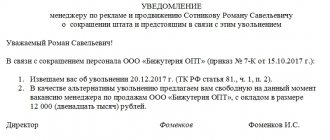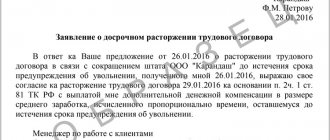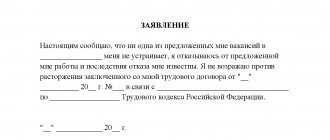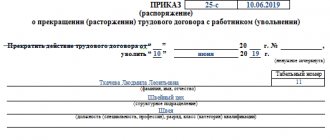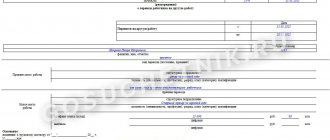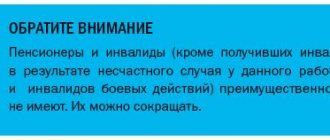Reducing the number of employees is one of the effective ways to reduce costs or slow down the pace of production activities if the organization's product has ceased to generate sufficient profit. In this article we will tell you how to avoid mistakes when reducing staff.
If an employer decides to reduce the number of employees, he needs to take into account all the nuances of this complex process. Mistakes made do not reduce, but, on the contrary, significantly increase personnel costs.
For example, a court may reinstate an employee at work and oblige the employer to pay him the average salary for the entire period of forced absence (Article 394 of the Labor Code of the Russian Federation, hereinafter referred to as the Labor Code of the Russian Federation), as well as to compensate for moral damages (Article 237 of the Labor Code of the Russian Federation). In this case, the employer is obliged to pay all legal costs (Article 88 of the Civil Procedure Code of the Russian Federation).
In addition, if an employee applies for protection of his rights to the labor inspectorate, if the reduction is incorrectly executed, the employer faces administrative liability under Art. 5.27 of the Code of Administrative Offenses of the Russian Federation.
Let's look at the typical mistakes that employers make when filing staff reductions.
WORKERS ARE NOT NOTIFIED ABOUT REDUCTION OR ARE NOTIFIED WITH VIOLATIONS
An important nuance is that absolutely all laid-off employees must be notified of the layoff and on time.
According to part two of Art. 180 of the Labor Code of the Russian Federation, the employer is obliged to warn employees in writing, against signature, about their layoff at least two months before dismissal.
If the employee refuses to read the notice or sign for familiarization with it, then the employer will have to read the notice to the employee out loud and draw up a report in which two or three employees who were present during the familiarization must sign (Example 2).
However, there are exceptions to the employee notice period.
Several days' notice. For example, if an employee has a fixed-term employment contract for a period of up to two months, then he must be notified in writing of the layoff at least three calendar days in advance (part two of Article 292 of the Labor Code of the Russian Federation). An employee who is employed in seasonal work should be notified in writing of the layoff at least seven calendar days in advance (part two of Article 296 of the Labor Code of the Russian Federation).
Notification in case of illness and vacation. If an employee needs to be notified of a layoff and he is on vacation or sick leave, it is better to wait until he returns to work and hand in the notification in person. But what if this is a remote worker or management demands that the employee be notified despite being on vacation?
In this case, you need to send a notice of layoff to all known addresses of the employee in a valuable letter with a list of attachments and a receipt receipt (Example 3). The date of notification is the date the employee receives the valuable letter.
If the employee is available by phone, it is worth calling him and telling him about the need to receive a notification. Moreover, this must be done over a loudspeaker and in front of witnesses. The conversation must be recorded in an act (Example 4). Such an act speaks of the employer’s good faith and confirms that he did everything possible to notify the employee of the layoff.
Alarming news delivered on time
The “lucky ones” whom the employer has decided to sacrifice to reduce staff should find out about this in advance. Within 2 months, employees will have written notice of their upcoming “freedom.” Soon-to-be-former employees must sign for this notice.
NOTE! Only handing over a notice against signature does not contradict the procedure. Oral announcements, negotiations, placing information on a stand, etc. the methods have no legal force: if the legality of the layoff is challenged, the employer will not be able to prove that he warned the employee on time.
DO NOT OFFER ALL SUITABLE VACANCIES
If there are vacancies in the organization, they should be offered to the laid-off employee (if they suit him in terms of qualifications and health) as they appear within two months, while the notice period for dismissal due to layoff is valid (part three of Article 81 of the Labor Code of the Russian Federation) .
Often, courts reinstate employees precisely because they were not offered all the vacancies. The courts carefully check whether the positions in the staffing table and in job offers coincide (see, for example, the Appeal ruling of the Krasnoyarsk Regional Court dated 02.02.2015 in case No. 33-949/2015, A-9).
It is necessary to offer not only positions that correspond to the employee’s qualifications, but also lower ones.
QUESTION ON THE TOPIC
Do I need to offer a vacant senior position?
If you know for sure that your qualifications are insufficient, you do not need to offer this vacancy (see the Appeal ruling of the Moscow City Court dated March 30, 2015 in case No. 33-10408/2015).
But if it is not known for sure whether the employee can hold a higher position (perhaps he has undergone additional training or has experience that is not reflected in the work book), the risk of disputes increases. For this purpose, we propose to inform the employer about qualification documents unknown to the employer in the layoff notice (see Example 1).
Thus, you need to ensure that there are no extra vacancies left in the staffing table (just in case). All vacancies that are not currently being searched should be excluded.
The employer is obliged to offer vacancies only in a given area, unless otherwise provided by the labor or collective agreement (see the Appeal ruling of the Moscow City Court dated December 24, 2012 in case No. 11-25754).
Let us note that the position in which a woman on maternity leave worked, in the opinion of most courts, is not considered vacant (see, for example, Determination of the Moscow City Court dated May 29, 2014 No. 4g/8-3516). This position is temporarily vacant - because the woman can return, and we don’t know when - in three months or three years.
Determining the working optimum
Before starting to select candidates for dismissal, the employer must answer the question of how many employees he intends to keep and in what positions. In other words, the staffing table should be revised. The employer makes a decision and, based on it, makes changes to the previously existing staffing table.
FOR YOUR INFORMATION! In the new schedule, the reduction should actually be real. It is unacceptable, along with the reduction in the number of employees or the abolition of some positions, to introduce others in their place, to which other people will need to be appointed.
The head of the company, having drawn up a new staffing table, issues an order for its approval. This is not yet an order for staff reductions and layoffs, but a mandatory preliminary procedure. It does not matter much in what form this order will be drawn up; it is important that it contains the date from which the new staffing table will be considered valid. The employer will build on this date when planning the next stages of reduction, in particular, notifying employees.
REDUCING “PROTECTED” WORKERS
Despite the fact that it is the employer’s right to determine the organizational structure and staffing, the law protects certain categories of employees who need state support. “Protected” workers include:
•pregnant woman (part one of Article 261 of the Labor Code of the Russian Federation);
•a woman with a child under three years of age (part four of Article 261 of the Labor Code of the Russian Federation);
•a single mother raising a child under 14 years of age or a disabled child under 18 years of age (or a person raising such a child without a mother) (part four of Article 261 of the Labor Code of the Russian Federation). According to paragraph 28 of the resolution of the Plenum of the Supreme Court of the Russian Federation dated January 28, 2014 No. 1, a single mother is considered a woman who raises her children (natural or adopted) and is engaged in their development independently, without a father. In particular, if the father:
– died, declared missing (you need to ask the employee for a death certificate, a corresponding court decision);
– deprived of parental rights, limited in parental rights (corresponding court decision);
– declared incompetent (partially capable) or due to health reasons cannot personally raise and support a child (court decision or certificate, for example, about disability);
– is serving a sentence in institutions executing a sentence of imprisonment (relevant certificate);
– avoids raising children or protecting their rights and interests. We are talking about divorced women who applied for the collection of alimony to the court and the bailiff service, but despite this, it was not possible to collect alimony (a certificate from the bailiff service that it was not possible to collect alimony);
– other situations (for example, when the paternity of the child has not been established and there is a dash on the birth certificate);
•a parent, if he is the sole breadwinner of a child under three years of age or a disabled child under 18 years of age in a family of three or more children under 14 years of age and the other parent (child’s representative) is not in an employment relationship (part four of Article 261 of the Labor Code of the Russian Federation ).
To reduce the risk of litigation, it is better not to lay off such employees.
Also note that workers under the age of 18 can be fired due to layoffs only with the consent of the labor inspectorate and the commission for minors (Article 269 of the Labor Code of the Russian Federation).
In addition, if an employee is a member of a trade union, he can be fired only with the consent of the primary trade union organization (part two of Article 82, 373 of the Labor Code of the Russian Federation).
And finally, do not dismiss an employee during the period of his temporary disability and while on vacation (part six of Article 81 of the Labor Code of the Russian Federation, subparagraph “a”, paragraph 23 of the resolution of the Plenum of the Supreme Court of the Russian Federation dated March 17, 2004 No. 2).
Legal basis
The Labor Code regulates such an event as a reduction in the number or staff of employees in articles relating to dismissal issues and providing for compensation and guarantees to employees.
The Labor Code regulates the reduction of the number or staff of employees in sufficient detail and clearly, but when applying the norms of the code, questions always arise. Judicial practice is of great importance; the Supreme Court often issues clarifications on the procedure for applying articles of the law, for example, Resolution of the Plenum of the Supreme Court No. 2 of March 17, 2004, which pays a lot of attention to this issue, is still relevant on this issue. The reduction in the number of employees occurs at the initiative of the employer; this basis for termination of the employment contract is formulated in Art. 81 Labor Code of the Russian Federation. Art. 178-180 are entirely devoted to guarantees and compensation for a person dismissed on such grounds.
THE PREFERENCE RIGHT TO REMAIN AT WORK DOES NOT TAKE CONSIDERATION
You may encounter such a problem during downsizing if there are several positions of the same name in the staffing table. For example, a department has three sales managers, but only one needs to be laid off. In this case, part one of Art. 179 of the Labor Code of the Russian Federation requires that the employer, when laying off workers, retains workers with higher labor productivity and qualifications.
Qualifications can be verified using an education document and work record, but assessing labor productivity will require some effort from the employer.
- How to evaluate labor productivity? It is not difficult to assess the productivity of working personnel - it is enough to find out whether employees comply with labor standards (time and output). The situation with assessing the productivity of knowledge workers is much more complicated. Here are some tips:
1. If the organization conducts an annual personnel assessment, we recommend attaching its results. The results of the certification, if any, will also be useful.
2. If the organization has established bonus indicators, the productivity of employees can be assessed by the size and frequency of bonuses awarded to them. You can also take into account the regular performance of additional work (for example, part-time or by special order). We recommend assessing the employee’s work discipline. If discipline is low or there are comments or reprimands, then such an employee does not have a preemptive right.
- How to Document Performance Evaluations. The first step is to issue an order to create a commission to determine the preferential right to remain at work. The order must contain the following provisions:
The results of the assessment must be indicated in the minutes of the meeting of the special commission. In court, the protocol is evidence that the employer took into account the preferential rights of employees. The protocol should be accompanied by tables assessing the employees’ compliance with production or service standards, plans, instructions, etc. (see table).
If labor productivity and qualifications of workers in identical positions are approximately equal, you should go further and give preferential rights to the following categories (part two of Article 179 of the Labor Code of the Russian Federation):
•family with two or more dependents;
•persons whose family does not have working family members;
•workers who, while working in the organization, received a work injury or occupational disease;
•disabled people of WWII and combat;
•workers who improve their skills without interruption from work in the direction of the employer;
•other categories of employees in accordance with the collective agreement.
Supporting documents should be requested from such employees. For example, an employee with two or more children must provide birth certificates, as well as a passport with registration confirming residence with children; combat disabled person - certificate.
THEY DO NOT NOTIFY THE EMPLOYMENT SERVICE AND THE TRADE UNION
In accordance with paragraph 2 of Art. 25 of the Law of the Russian Federation dated April 19, 1991 No. 1032 - 1 “On employment in the Russian Federation” (as amended on July 29, 2017, hereinafter referred to as Law No. 1032-1) on reducing the number or staff, even if only one position or one employee, you must notify the employment service no later than two months in advance. If the reduction is massive, three months before the start of the reduction. Each region has its own notification form. It should be clarified on the websites of regional employment services. Let's give an example of a notification in Moscow (Example 5).
The mass scale criterion is determined by sectoral, territorial or regional agreements between trade unions and employers (part one of Article 82 of the Labor Code of the Russian Federation).
If these agreements are not applicable to a specific employer, you must be guided by clause 1 of the Regulations on the organization of work to promote employment in conditions of mass layoffs (approved by Government Decree No. 99 dated 02/05/1993).
According to part one of Art. 82 of the Labor Code of the Russian Federation, if the organization has a trade union, it must be notified within the same time frame (Example 6).
Algorithm of actions
If an employer needs to correctly reduce the number of employees, step-by-step instructions will help you do this without missing anything important.
Step 1. Issue an order.
Step 2. Identify employees who cannot be laid off.
Step 3: Conduct a personnel audit to identify those who have advantages over others in the same positions.
Step 4. Send notices of layoffs (to employees, trade union, employment center).
Step 5. Offer vacancies to those who are planned to be fired.
Step 6. Dismiss those who did not agree to the transfer (fill out documents, pay what is due).
We will analyze in detail the procedure for reducing the number and staff of employees step by step.
PERSONNEL DOCUMENTS ARE COMPLETED WITH ERRORS
Errors in the preparation of personnel documents can lead to fines and even reinstatement of the employee. To avoid them, you need to carefully formalize his dismissal on the last day of work (paragraph two of the first part of Article 84.1 of the Labor Code of the Russian Federation, clause 35 of the Decree of the Government of the Russian Federation of April 16, 2003 No. 225).
Below we list the actions of the employer on the last working day of the dismissed employee.
- We issue a dismissal order. The order is drawn up according to the unified form No. T-8 or No. T-8a [1] or according to the form approved by the organization (Example 7). If the order is drawn up later than the day of dismissal, in a controversial situation the court will declare it invalid.
The employee must be familiarized with the order against signature. If you refuse to familiarize yourself, you must draw up a corresponding act, which must be signed by two or three employees (Example 8).
- We draw up a note-calculation. The calculation note is a mandatory document for publication and is sent to the accounting department on the day the employee is dismissed. It is drawn up either according to the unified form No. T-61 or according to the form approved by the organization. In it, the personnel officer reflects the number of days of unused or advance-used vacation (Example 9).
- We make an entry in our personal card. An entry about the dismissal of an employee must be made in section XI of the personal card of Form No. T-2, which the employee must be familiarized with against signature (Example 10).
- We issue a work book. On the day of dismissal, the employee must be given a work book with a record of dismissal (Article 84.1 of the Labor Code of the Russian Federation) against signature in the work record book (Example 11).
If an employee refuses to receive a work book, a statement about this must be drawn up signed by two or three employees (Example 12).
If the employee does not show up to pick up the work book, you must send him a notice before the end of the working day about the need to pick up the work book (Example 13) or give written consent in any form to send it by mail (part six of Article 84.1 of the Labor Code of the Russian Federation). It is better to send the notice to all known addresses of the employee to increase the likelihood of receiving it.
- We issue certificates. Upon dismissal, the employer is also obliged to provide the employee with:
•a certificate of the amount of his earnings, on which insurance contributions to the Social Insurance Fund were calculated (Part 2 of Article 4.1 of the Federal Law of December 29, 2006 No. 255-FZ “On Compulsory Social Insurance in Case of Temporary Disability and in Connection with Maternity”[2 ]);
•a certificate with information on accrued and paid insurance contributions to the Pension Fund of the Russian Federation (Article 11 of the Federal Law of April 1, 1996 No. 27-FZ “On individual (personalized) accounting in the compulsory pension insurance system” [3]).
